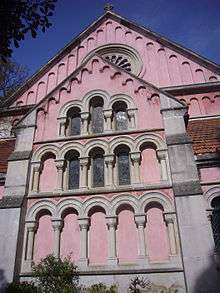St. George's Church, Lisbon
| St George's Church, Lisbon | |
|---|---|
 | |
| Coordinates: 38°42′59″N 9°09′38″W / 38.71641°N 9.16045°W | |
| Country | Portugal |
| Denomination | Church of England |
| Website | Greater Lisbon Chaplaincy |
| History | |
| Dedication | Saint George |
| Consecrated | 17 March 1889 |
| Architecture | |
| Architect(s) |
John Medland and Charles Edward Powell |
| Style | Romanesque Revival |
| Administration | |
| Parish | Greater Lisbon Chaplaincy |
| Archdeaconry | Gibraltar |
| Diocese | Europe |
| Province | Canterbury |
| Clergy | |
| Chaplain(s) |
Vacant position Paula Rennie - Minister resident in the Chaplaincy |
St George's Church is the only English-speaking Anglican congregation in Lisbon, Portugal. It is at Rua São Jorge 6, north of the Estrela Garden.
History
In 1654 a treaty between Oliver Cromwell and John IV of Portugal (signed on his behalf by João Rodrigues de Sá e Menezes, Count of Penaguião) allowed English residents in Portugal to "profess their own Religion in private houses... and that finally a Place be allowed for them to bury their dead". A chaplaincy was established, with services held in the home of the British Envoy.[1] Notable burials in the cemetery include the tomb of the writer Henry Fielding (1707–54).
Anglicans in Portugal petitioned for permission to build a church, but until the early 19th century the Portuguese Inquisition prevailed on the monarch not to grant it. A church of St George the Martyr was built in the cemetery in 1882 but burnt down in 1886. The present church was designed by the London-based architects John Medland and Charles Edward Powell and consecrated in 1889.[1] It is a Romanesque Revival building with a narthex, blind arcades and rose window on its west front.
The cemetery includes 31 Commonwealth War Graves: five from the First World War and 26 from the Second.[2] 29 are in individual plots; two are in private family vaults. They include members of the British Army, Royal Navy, Royal Air Force, Royal Canadian Air Force, Merchant Navy and British Overseas Airways Corporation.
Greater Lisbon Chaplaincy
In 1984 St George's was amalgamated with St Paul's Church, Estoril to form the Greater Lisbon Chaplaincy.[1] This is part of the Church of England Diocese in Europe.
Fincham Pipe Organ
When the existing church was designed, traditional choir stalls were included in front of the Sanctuary and Henry Fincham of London built and installed a two-manual pipe organ for £526. It has 25 ranks with 61-note compass of the manuals and 30-note compass of the pedals. There were two minor changes to the Great organ which, in its original state, did not include mutation stops.
This is the current disposition of the organ after 125 years of use:
Great – I
- 8' Open Diapason
- 8' Lieblich Gedacht
- 8' Gambe
- 4' Principal
- 2 2⁄3' Nazard
- 2' Fifteenth
- 1 3⁄5' Tierce
- 8' Corno de Bassetto
- 8' Trumpet
Pedal
- 16' Grande Open Diapason
- 16' Bourdon
Swell – II
- 16' Double Open Diapason
- 8' Horn Diapason
- 8' Stopped Diapason
- 8' Vox Angelica
- 8' Voix Celeste
- 4' Principal
- 4' Flûte a Cheminee
- 2' Fifteenth
- III Mixture
- 8' Cornopean
- 8' Hautboy
- 8' Vox Humana
- Swell Tremulant
- Swell to Great Super
- Swell to Great
- Swell to Pedal
- Great to Pedal
- Swell shades open catch mechanism
- 5 pre-set piston shoes
See also
- St Andrew's Church, Lisbon – Church of Scotland
- Estrela Basilica – Roman Catholic church and Carmelite convent nearby
References
- 1 2 3 "The History of St George's Church". Greater Lisbon Chaplaincy. Retrieved 13 August 2014.
- ↑ "Lisbon (St George) British Churchyard". Cemetery details. Commonwealth War Graves Commission. Retrieved 13 August 2014.
External links
| Wikimedia Commons has media related to English Cemetery in Lisbon. |